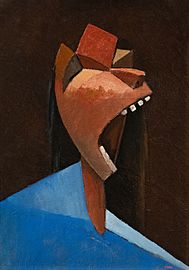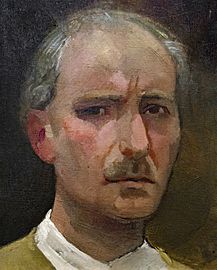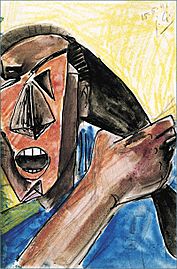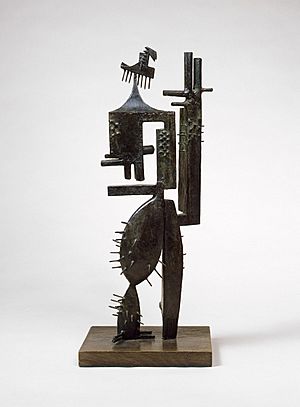Julio González (sculptor) facts for kids
Quick facts for kids
Julio González
|
|
|---|---|
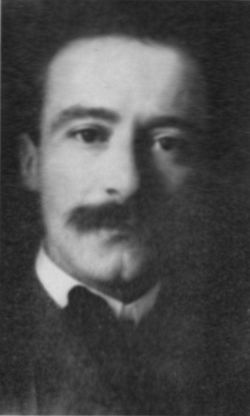
Julio González, 1912
|
|
| Born |
Julio González Pellicer
21 September 1876 Barcelona, Spain
|
| Died | 27 March 1942 (aged 65) Arcueil, France
|
| Education | Cercle Artístic de Sant Lluc |
| Known for | Painting, Sculpture |
| Movement | Cubism |
Julio González i Pellicer (born September 21, 1876 – died March 27, 1942) was a Spanish sculptor and painter. He was born in Barcelona. Julio González became famous for using iron in new and exciting ways for modern sculpture.
His family had a long history of working with metal and art. His grandfather was a goldsmith. His father, Concordio González, was a metalsmith. He taught Julio how to work with metal when Julio was a child. Julio's mother, Pilar Pellicer Fenés, also came from a family of artists.
Julio went to a Catholic school called Circol Artist Sant Luc. This school taught art in a way similar to old medieval art guilds. It was also inspired by the Arts and Crafts movement from England.
Contents
Julio González's Life Story
Early Life and Learning
Julio González Pellicer was born in Barcelona, Spain. This happened on September 21, 1876. His family had been metalsmiths for many years. His grandfather was a goldsmith in Galicia.
Julio's father, Concordio González, owned a workshop. Julio learned how to work with gold, silver, and iron from his father. His older brother, Joan González, also learned these skills. All three González children studied at Circol Artist Sant Luc. This school based its teaching on old art guilds. It was also influenced by the Arts and Crafts movement from England.
In 1896, Julio's father passed away. The family workshop then went to Joan, the older brother. Both Joan and Julio focused on their metalwork and art dreams. Around the year 1900, they often visited Els Quatre Gats. This was a café where many artists met. They especially met artists linked to modernisme. There, they became friends with artists like Joan Miró and Pablo Picasso.
Around the start of the 20th century, Pablo Picasso and Julio González became very good friends. Julio moved to Paris in 1902. But he often traveled back to Barcelona in the early 1900s. The Picasso Museum in Barcelona shows their close friendship. There is a drawing called "Julio González and the Robust Man Seen from Behind." They stayed close friends until 1908. Experts are not sure why their friendship ended then. But it seems it was linked to an earlier disagreement with Julio's brother, Joan.
Moving to Paris
In Paris, Julio joined a group of Spanish artists. This group lived in Montmartre. It included artists like Pablo Gargallo, Juan Gris, and Max Jacob. In 1918, he became interested in welding for art. He learned this skill while working at the Renault factory in Boulogne-Billancourt.
Welding later became his main way of creating sculptures. But during this time, he also painted. He also made many pieces of jewelry. In 1920, he reconnected with Picasso. Julio later helped Picasso with the technical side of making iron sculptures. He also helped Picasso with his studies into analytic cubism. He even made the metal frames for Constantin Brâncuși's plaster sculptures.
In the winter of 1927–28, Julio showed Picasso how to use oxy-fuel welding and cutting. After their friendship restarted, Picasso and González worked together. They created a piece called Woman in the Garden between 1928 and 1930. From October 1928 until 1932, both artists worked together. In 1932, González was the only artist with whom Picasso shared his personal art notebook.
Picasso's influence changed González's style a lot. González was fifty years old at the time. He started using iron instead of bronze. He also focused on lines instead of solid shapes. González began to create a new visual language in sculpture. This new style would change his art career forever.
-
Cap cridant, at the Museu Nacional d'Art de Catalunya
-
Self-portrait, 1920, at the Museu Nacional d'Art de Catalunya
Iron Sculptures (1932–1937)
During this time, González created iron sculptures. These works made him known as "the father of all iron sculpture of this century." In the early 1930s, not many artists used forged or welded metal for their art. This was because many artists did not work directly with the metal. Instead, artists worked with a foundry and skilled technicians. These experts would create the artworks for them.
González was special because his work needed him to be actively involved. This required the skills he learned from a long and special training. In 1937, he showed his work at the Spanish Pavilion. This was at the World Fair in Paris. His sculpture La Montserrat stood near Picasso's famous painting Guernica. He also showed his work at the Cubism and Abstract Art exhibit. This was at the Museum of Modern Art in New York.
Later Years (1938–1942)
As González got older, between 1938 and 1940, he drew more. These later works showed bigger problems and personal worries. They reflected González's sad feelings about the Spanish Civil War and World War II.
Julio González was directly affected by World War II. His daughter Roberta González married a German painter, Hans Hartung, in 1938. Hans was also Julio's assistant. When Germany invaded France, Roberta and Hans had to separate from the family. This was because Hans Hartung was against the Nazis. The German secret police wanted to find him.
While separated from his daughter and son-in-law, Julio González drew pictures of people. He also worked on plaster casts. The drawings and castings he made in the last two years of his life show his suffering and sadness. He felt this way about unfair rule and war. Julio González passed away in Arcueil, France, on March 27, 1942.
Where to See His Art
Many public art collections have works by Julio González. These include:
- The Art Institute of Chicago
- The Cleveland Museum of Art
- The Hirshhorn Museum and Sculpture Garden (Washington D.C.)
- The Honolulu Museum of Art
- The Kröller-Müller Museum (Otterlo, Netherlands)
- The Los Angeles County Museum of Art
- The Luís Ángel Arango Library (Bogotá, Colombia)
- The Mary and Leigh Block Museum of Art (Northwestern University, Evanston, Illinois)
- Musée des Beaux-Arts de Rennes (France)
- Museo Nacional Centro de Arte Reina Sofía (Madrid)
- Museo Patio Herreriano de Valladolid (Spain)
- Museu Nacional d'Art de Catalunya (Barcelona, Spain)
- The Museum of Modern Art (New York City)
- The Nasher Sculpture Center (Dallas, Texas)
- The National Gallery of Scotland (Edinburgh)
- The Peggy Guggenheim Collection (Venice)
- The Philadelphia Museum of Art
- The Pompidou Center (Paris)
- The Solomon R. Guggenheim Museum (New York City)
- The Tate Gallery (London)
The largest collection of his art is at the IVAM (Valencia's Institute of Modern Art). It is in the city of Valencia, Spain. This collection has almost 400 pieces.
Famous Artworks
- Still life II, around 1929, kept at MNAC
- Raised Left Hand, kept at MNAC
See also
 In Spanish: Julio González para niños
In Spanish: Julio González para niños


